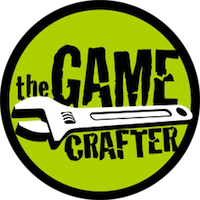


Scarborough Fair
Requirements
Description
Scarborough Fair is a resource selling game for 2-4 players. Players will buy and sell four resources; Parsley, Sage, Rosemary and Thyme. They will set the prices that they sell each resource at, place Merchants in tents and buy Victory Points to give them the lead. But the customer is a shrewd shopper so don’t raise your prices too high or you’ll be left holding resources that you can’t sell. Pick the prime locations, corner a market or undercut your opponents to win.

 On a player’s turn, do the following in order:
On a player’s turn, do the following in order:
- Reveal the next customer card
- Take any one of four types of actions.
- Move the customer.
After each player’s turn, play passes to the player on the left. If the customer deck is exhausted, shuffle the discarded cards and start over.
The four types of actions are:
- Adjusting the Market
- Buying Resources
- Placing Merchants
- Buying Victory Points
Adjusting the Market
Players may Adjust the Market by changing the price that
they sell each resource. The player markers in the market
indicate the price at which the player is willing to sell each
type of resource. When adjusting the market, the player may move one or two markers up or down by one.

Buying Resources
When a player Buys Resources, they may buy as many resources as they can afford. However, a player may not have more than 15 total resources at any one time. Each resource costs 2 gold. The player takes resource markers from the supply on the board and places the markers in front of them. Then the player’s gold marker is moved down by two for each resource purchased.
If a player has no resources and not enough money to buy a resource, they may instead take one resource marker for free from supply.
Placing Merchants
When a player Places Merchants, they take one of their
merchants and put it in any unoccupied tent. Once a player has placed all of their merchants, they may instead move a merchant from one tent to another
unoccupied one.

Buying Victory Points
Players may Buy Victory Points. Victory point markers are found along the gold tracker. The square that they are found on represents their cost. Despite the varying cost, each victory point marker is worth one victory point. To buy a victory point marker, a player takes the victory point marker from the gold tracker and places it in front of them and then moves their gold marker down by the price paid.
Even if they can afford it, a player is not allowed to buy more than one victory point marker on the same turn.


The customer moves and purchases based on what is shown on the customer card.

The symbol at the bottom of the card indicates the type of event that the customer is interested in.
The customer will move from its current location to the nearest stage that is hosting this type of event. “Nearest” is defined as the number of paths that are required to be traveled to reach a stage. Neither the physical length of the path(s) nor the number of tents along a path(s) is relevant.
In the event of a tie, the current player may choose from among any of the nearest stages.
If no stage is hosting the type of event that the customer is interested in, the current player chooses any adjacent stage to move the customer.
When the customer moves to a new stage, the event token at that stage is flipped over and placed on the stage that the customer was previously located.


The customer will attempt to purchase resources while traveling from one stage to another. The resource type and amount are shown on the customer card.

The customer will consider buying resources from any player that has a merchant in a tent that is passed along the customer’s route.
From among the players being considered, the customer will choose the player that sells the resource for the lowest price as indicated in the market.
In the event of a tie, the customer will choose from among the tied players by picking the merchant from the tied players that was passed first along the route.
The customer will then purchase resources from the chosen player as long as that player has resources available and the customer has not yet reached their order amount. If a player does not have enough of a resource to fulfill a customer’s request, they fulfill as much as they can and then the remainder of the customer order may be fulfilled by other players using the same rules described above. Purchases are mandatory; a player may not choose not to sell a resource.
Sold resource markers are returned to supply and the player(s) that sold resources move their gold markers up by the amount of
resources sold times that price that they were sold at as
indicated in the market.
Walk-Through
Review
Unboxing
Components
| Component | Quantity | Photo |
|---|---|---|
| {{item.name}} | {{item.quantity}} |
|
Vitals
| Average Rating | 4 reviews |
|---|---|
| Publish Date | November 04, 2012 |
| Edition | 10th Anniversary |
| Department | Games |
| Tags | {{tag.properties.name}} |
Why buy this?
This a must-have for your game library.
- Resource Selling
- Small Market Strategy
- Wooden Game Parts
Related Games
Downloads
Allen Lamb
Notes
- This game contains a premium upgrade called UV Coating that makes the printed components more durable.
- This game contains a premium upgrade where the printed components will be embossed with a linen texture.
See It In Action
Ratings and Reviews
{{review.properties.review|truncate(review.stash('truncate')||200)}}

